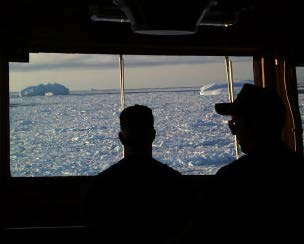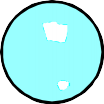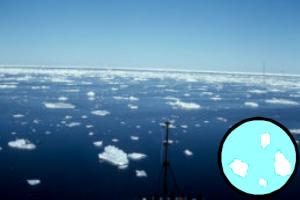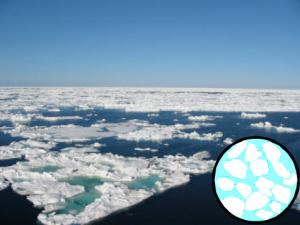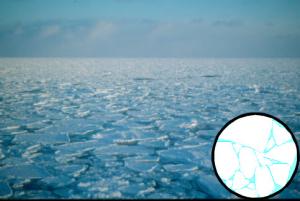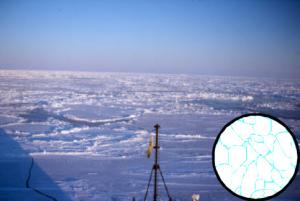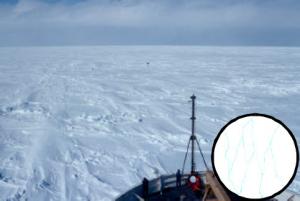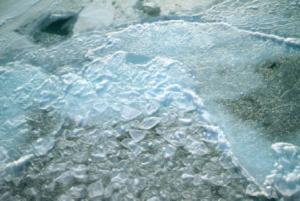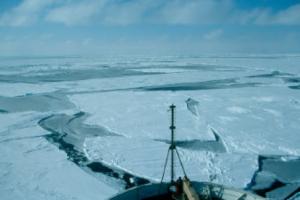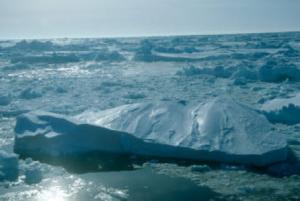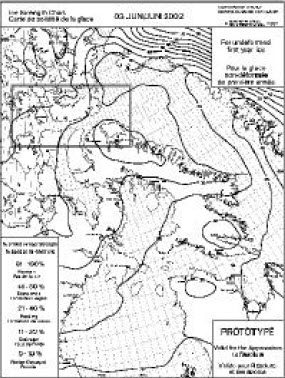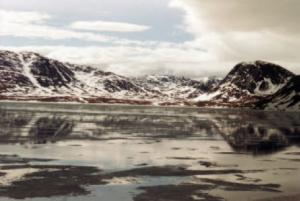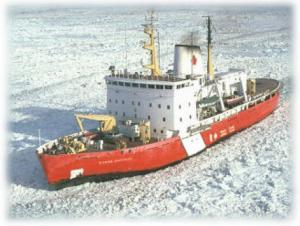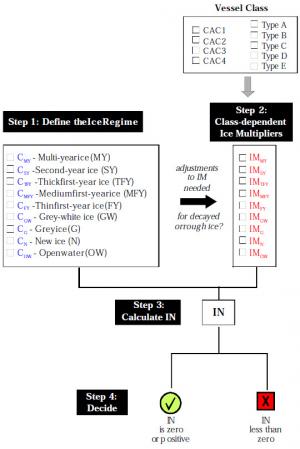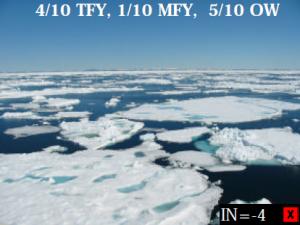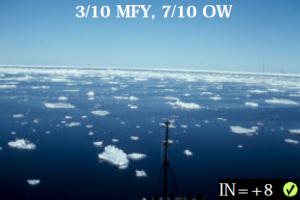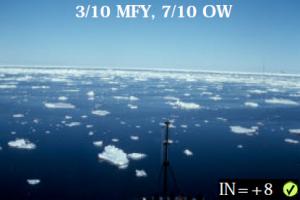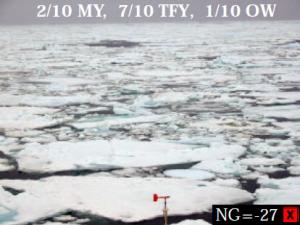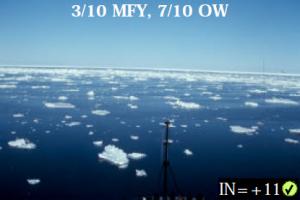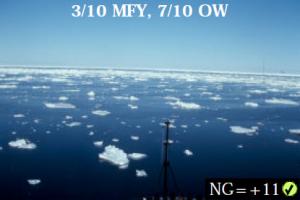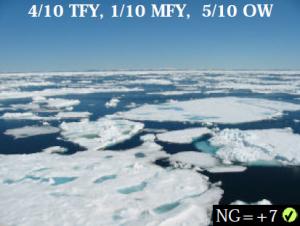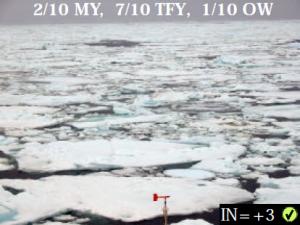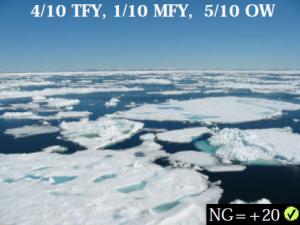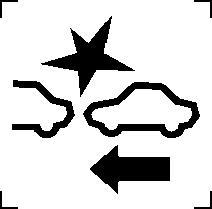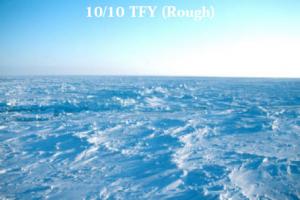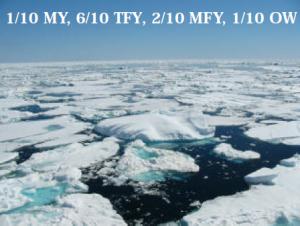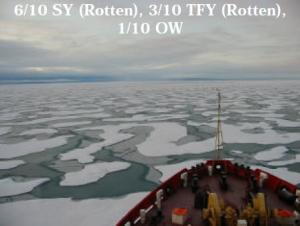This booklet was developed by Dr. Garry Timco and Dr. Michelle Johnston of the Canadian Hydraulics Centre, National Research Council of Canada. Support and funding for its development was provided by Transport Canada.
Photographs used in this booklet were provided by several individuals and organizations including Bob Gorman, Michelle Johnston, Garry Timco, the Canadian Coast Guard, and Fednav Limited. A number of the photographs were taken by Ice Service Specialists of the Canadian Ice Service.
January 2003
Preface
This book was developed as a reference guide for the Arctic Ice Regime Shipping System (AIRSS). It is a pictorial guide that outlines the four steps that are needed to apply the Ice Regime System. First, the user characterizes the Ice Regime. Second, the Class-dependent Ice Multipliers are obtained. Third, information about the Ice Regime and the Ice Multipliers is combined to determine the Ice Numeral. Finally, the Ice Numeral is used to decide whether the vessel should proceed or take an alternate route.
It is hoped that the information contained in the following pages will help the reader understand the Ice Regime System while providing a concise methodology for applying AIRSS.
For complete information regarding the regulatory requirements for ships operating in Canadian Arctic waters, please check the Transport Canada website www.tc.gc.ca. The last page of this booklet contains details about additional contacts.
Table of Contents
- I. The Arctic Ice Regime Shipping System
- II. Ice Regimes
- III. Ice Numerals
- IV. Four Step Process: Summarized
- V. Detailed Examples for Each Vessel Class
- VI. Calculated Examples of the Ice Numeral
- VII. Further Information
I. The Arctic Ice Regime Shipping System
Defining the Ice Regime Shipping System
Ice in the Arctic is a very complex and dynamic material. It has a wide range of thickness, concentration, age and roughness. Moreover, ice conditions in the Arctic change throughout the year.
There are a number of vessels that travel in Canada's Arctic, and it is important that their transit through the ice is a safe one. This is important for both personnel safety as well as preventing pollution in the Arctic.
How can this be done?
Transport Canada has implemented a Regulatory Standard that is intended to minimize the risk of pollution in the Arctic due to damage of vessels by ice. It is called AIRSS, for "Arctic Ice Regime Shipping System".
AIRSS combines information on the ice conditions and a ship's capability in ice to assess the potential for damage from the ice. It uses the concept of an "Ice Regime" to characterize the ice.
What is an Ice Regime?
An Ice Regime is a region of ice with more-or-less consistent ice conditions. From a navigation standpoint, it is an area in which there is the likelihood of impacting certain ice types, while maintaining a constant mode of navigation. Basically, the Ice Regime is the ice that the ship will likely encounter.
The Ice Regime takes into account several important factors of the ice: concentration, thickness, age, state of decay, and roughness.
CCGS LOUIS S. ST.-LAURENT
Why Use an Ice Regime System?
Ice has caused significant damage to vessels in the Arctic. There have been over 200 reported damage events over the past 25 years. Approximately one-third of those events had the potential to cause pollution.
AIRSS is intended to minimize the risk of damage by taking into account the actual ice conditions that vessels sail through.
Damage caused by Ice
How the Ice Regime System Works
AIRSS takes into account a vessel's ability to travel safely in all types of ice conditions. Because different vessels have different capabilities in ice-covered waters, each vessel is assessed and assigned to a Vessel Class. This rating reflects the strength, displacement and power of the vessel. The relative risk of damage to a vessel by different types of ice is taken into account using "weighting" factors, called Ice Multipliers.
In the Ice Regime System, a simple calculation relates the strength of the ship to the danger presented by different ice regimes. The calculation gives an Ice Numeral. Ice regimes that are not likely to be hazardous have zero or "positive" Ice Numerals. Those regimes that could be dangerous have "negative" Ice Numerals. As always however, the safety of the ship is the responsibility of the Master.
The Ice Regime System can be applied using four steps.
- Step 1: Characterize the Ice Regime
- Step 2: Determine the Class-dependent Ice Multipliers
- Step 3: Calculate the Ice Numeral
- Step 4: Decide whether to proceed
These steps are discussed in the following pages.
II. Ice Regimes
Characterizing the Ice Regime
AIRSS relies upon accurately assessing the ice conditions. The Canadian Ice Service (CIS) issues Ice Charts to provide an overview of the ice conditions in different geographic regions. Ice Charts are produced using the most current available technology. They give an excellent indication of the general ice conditions in an area.
As such, Ice Charts are one of the most useful resources to provide a ship with an overview of the ice conditions in a certain area, in advance of when it is needed. That information can be used successfully for strategic planning. Ice Charts are also useful when the ship is confronted with difficult ice conditions, since the Charts can be used to determine alternate routes.
Although Ice Charts have an important role for vessels traversing ice-covered regions, their importance is, of course, no substitute for real-time observations made from the bridge. AIRSS relies upon up-to-date information that is obtained directly from the bridge and integrates that real-time information with the capability of each vessel class. In effect, this results in customized routing for each vessel, depending upon its ice-worthiness.
CIS Ice Chart
The primary factors used to define the Ice Regime are as follows:
Ice Concentration
Ice coverage in an area is determined by its total concentration, expressed in "tenths". AIRSS uses the partial concentration of each ice type in determining the Ice Numeral.
less than 1 tenth - open water
1 - 3 tenths - very open drift
4 - 6 tenths - open drift
7 - 8 tenths - close pack/drift
9 tenths - very close pack
9+ tenths - very close pack
10 tenths - compact/consolidated ice
less than 1 tenth - open water
1 - 3 tenths - very open drift
4 - 6 tenths - open drift
7 - 8 tenths - close pack/drift
9 tenths - very close pack
9+ tenths - very close pack
10 tenths - compact/consolidated ice
Stages of Development
Ice has the following Stages of Development:
New (N) (less than 10 cm thick) Sea ice that is in early stages of formation. This ice is less than 10 cm thick and in small platelets or lumps, or ice in a soupy-looking layer. New ice is usually subdivided into frazil, grease ice, slush or shuga.
Nilas (NI) (less than 10 cm thick)
A thin elastic crust of floating ice that easily bends from waves and swells. It has a matte surface appearance.
Young Ice (YN) (10 to 30 cm thick)
Young ice is subdivided into the following sub-stages:
Grey (G) - Young ice, 10 to 15 cm thick, that is less elastic than Nilas. It often breaks from swells.
Grey-white (GW) - Young ice, 15 to 30 cm thick.
Thin First-year Ice (FY) (30 to 70 cm thick)
Sea ice that grows from Young Ice and is 30 to 70 cm thick. This is separated into stage 1 (30 to 50 cm thick) and stage 2 (50 to 70 cm thick).
Medium First-year Ice (MFY) (70 to 120 cm thick)
Sea ice that is 70 to 120 cm thick.
Thick First-year Ice (TFY) (> 120 cm thick)
Sea ice that is greater than 120 cm (1.2 m) thick.
Second-year Ice (SY)
Sea ice that has survived one melt season. It stands higher out of the water than first-year ice. Summer melting has often smoothed and rounded it.
Melt water puddles in the summer are often greenish-blue.
Multi-year Ice (MY)
Sea ice that has survived more than one melt season. This ice can be more than 3 m thick and is very strong. It has a characteristic bluish colour and usually has a higher freeboard than first-year ice. It usually has a weathered, undulating surface.
Glacial Ice
Ice that has originated from a glacier that calved into the sea.
New (N)
First-year sea ice, small floes less than 10 cm thick
Nilas (NI)
First-year sea ice sheet less than 10 cm thick
Grey Ice (G)
First-year ice that is 10 to 15 cm thick
Grey-white Ice (GW)
First-year ice that is 15 to 30 cm thick
Thin First-year Ice (FY)
First-year ice that is 30 to 70 cm thick
Medium First-year Ice (MFY)
First-year ice that is 70 to 120 cm thick
Thick First-year Ice (TFY)
First-year ice that is greater than 120 cm thick
Second-year Ice (SY)
Sea ice that has survived one melt season
Multi-year Ice (MY)
Sea ice that has survived more than one melt season
Glacial Ice
Ice of glacial origin
Stages of Decay
During the spring, the sea ice begins to melt and decay, with a resultant decrease in strength. The Stages of Decay of sea ice are:
- No Melt (winter)
- Snow Melt
- Ponding
- Thaw Holes (drainage)
- Rotten
The Regulatory Standard of AIRSS takes into account the Stage of Decay by adding a value of +1 to the Ice Multiplier for the ice type that has Thaw Holes (and is in the process of draining) or is Rotten. This bonus can be applied to multi-year ice, second-year ice, thick first-year ice or medium first-year ice. Great caution should be exercised if applying a decay factor to multi-year ice, as this type of ice is responsible for the majority of ship damage events in the Arctic.
Recent research has provided new insight on the decay of sea ice. The Canadian Ice Service, with assistance from the Canadian Hydraulics Centre, is developing weekly Ice Strength Charts for the Canadian Arctic. The charts will provide information on the Stage of Decay (or ice strength) of level, first-year ice.
The photographs on the following pages can be used as a guide to the application of the decay bonus.
CIS Ice Strength Chart (prototype)
No Melt (Winter conditions)
Snow Melt
Ponding
Thaw Holes
Add + 1 to the Ice Multipliers for MY, SY, TFY and MFY ice
Rotten
Add + 1 to the Ice Multipliers for MY, SY, TFY and MFY ice
Ice Roughness
AIRSS also takes into account the Ice Roughness. If the ice regime has an overall concentration of 6-tenths or greater and more than one-third of an ice type is deformed by ridges, rubble or hummocking, the Ice Multiplier for the deformed ice must be decreased by 1.
Rough Ice
Subtract 1 from the Ice Multiplier
III. Ice Numerals
Vessel Classification
A ship is characterized by its "Vessel Class". The class of the vessel reflects its structural strength, displacement, and power for breaking ice. The Vessel Class is determined by Transport Canada regulations based on the vessel's characteristics.
The classes are designated as either "Type" vessels, which are designed for first-year sea ice, or "CAC - Canadian Arctic Class" vessels which are designed for more severe ice conditions.
| Vessel
Class |
Maximum Allowable
Ice Type |
Ice Thickness
(cm) |
|---|---|---|
| CAC1 | No Limit | no limit |
| CAC2 | Multi-year | no limit |
| CAC3 | Second -year | no limit |
| CAC4 | Thick First-year | > 120 |
| Type A | Medium First-year | 70 -120 |
| Type B | Thin First-year (stage 2) | 50 - 70 |
| Type C | Thin First-year (stage 1) | 30 - 50 |
| Type D | Grey-white | 15 - 30 |
| Type E | Open Water / Grey | 10 - 30 |
Ice Multipliers
Some examples of ice-capable vessels are shown below:
FEDERAL POLARIS
Fednav Ltd. Arctic cargo vessel
PIERRE RADISSON
Canadian Coast Guard Icebreaker
Ice Multipliers (IM) are numbers that are used to indicate the severity of each Ice Type for the vessel. These numbers can be positive or negative. Positive numbers represent less risk to the vessel. Negative numbers represent more severe ice for the vessel.
Transport Canada regulations assign a unique set of Ice Multipliers to each Vessel Class.
It is important to understand that the basic Ice Multipliers for a vessel do not change. However, when appropriate, the Multipliers should be adjusted to account for decayed ice (less severe conditions) or rough ice (more severe conditions).
The Ice Multipliers are fundamental to the Arctic Ice Regime Shipping System because they are used to calculate the Ice Numeral (IN), as shown on the opposite page.
Calculating the Ice Numeral
An Ice Numeral (IN) is calculated for each Ice Regime. Using arithmetic, the Ice Multipliers (IM) for the vessel and the Ice Concentrations (C- in tenths) of each ice type are combined in the following form:
multi-year (MY) ice → [CMY x IMMY]
second-year (SY) ice → + [CSY x IMSY]
thick first-year (TFY) ice → + [CTFY x IMTFY]
medium first-year (MFY) ice → + [CMFY x IMMFY]
thin first-year (FY) ice → + [CFY x IMFY]
grey-white (GW) ice → + [CGW x IMGW]
grey (G) ice → + [CG x IMG]
new (N) ice → + [CN x IMN]
open water (OW) → + [COW x IMOW]
IN = ?
The value of the Ice Numeral is used to determine if a vessel is allowed to enter the Ice Regime. If the Ice Numeral is zero or positive, the vessel is allowed to proceed. If the Ice Numeral is negative, the vessel should not proceed and an alternate route must be found.
Table of Ice Multipliers
The Ice Multiplier Table for AIRSS is given below for Type vessels and CAC4 and CAC3 vessels. There are no Ice Multipliers for CAC2 and CAC1 vessels.
Ice Multipliers for each Vessel Class
|
|
Type Vessels |
CAC |
|||||
|---|---|---|---|---|---|---|---|
|
Ice Types |
E | D | C | B | A | 4 | 3 |
| MY Multi-Year Ice | -4 | -4 | -4 | -4 | -4 | -3 | -1 |
| SY Second Year Ice | -4 | -4 | -4 | -4 | -3 | -2 | 1 |
| TFY Thick First Year Ice > 120 cm | -3 | -3 | -3 | -2 | -1 | 1 | 2 |
| MFY Medium First Year Ice 70 -120 cm | -2 | -2 | -2 | -1 | 1 | 2 | 2 |
| FY Thin First Year Ice
stage 2 50 -70 cm stage 1 30 -50 cm |
-1 -1 |
-1 -1 |
-1 1 |
1 1 |
2 2 |
2 2 |
2 2 |
| GW Grey-White Ice 15 -30 cm | -1 | 1 | 1 | 1 | 2 | 2 | 2 |
| G Grey Ice 10 -15 cm | 1 | 2 | 2 | 2 | 2 | 2 | 2 |
| NI Nilas, Ice Rind < 10 cm
N New Ice < 10 cm Brash (ice fragments) Bergy Water Open Water |
2
" " " " |
2
" " " " |
2
" " " " |
2
" " " " |
2
" " " " |
2
" " " " |
2
" " " " |
Ice Decay: If MY, SY, T FY or MFY ice has Thaw Holes or is Rotten, add 1 to the IM for that ice type.
Ice Roughness: If the total ice concentration is 6/10s or greater and more than one-third of an ice type is deformed, subtract 1 from the IM for the deformed ice type.
IV. Four Step Process: Summarized
How to Apply AIRSS
The Arctic Ice Regime Shipping System (AIRSS) can be applied using the four steps listed below, and as shown on the opposite page.
Step 1: Define the Ice Regime, based upon ice conditions
Ice regimes are characterized by their ice concentration and the types of ice in that Regime, including open water. Ice types are identified by their stage of development.
Determine which types of ice are decayed or have surface roughness.
Step 2: Obtain Class-dependent Ice Multipliers (IM) and make any necessary adjustments
Obtain the Ice Multipliers for your Vessel Class, as established by Transport Canada. If any ice types are decayed or rough, make the appropriate adjustment to the Ice Multipliers for those ice types.
Step 3: Calculate the Ice Numeral (IN)
The Ice Numeral (IN) integrates information about the Ice Regime and the Vessel Class. For each Regime, an IN should be calculated by combining the concentration of each ice type (including open water) and the Class-dependent Ice Multiplier associated with each ice type. Calculate the Ice Numeral using the format given on page 29.
Step 4: Decide whether to proceed or to take an alternate route
After the Ice Numeral (IN) has been calculated, use it to decide whether to proceed into an Ice Regime or choose an alternate route. Use this criterion: If the IN is zero or positive, the ship may proceed with due diligence. If the IN is less than zero, the ship must find an alternate route.
V. Detailed Examples for Each Vessel Class
Type E Vessels
The Ice Multipliers (IM) for Type E vessels are:
| Multi-year | → | IMMY | -4 |
| Second-year | → | IMSY | -4 |
| Thick First-year | → | IMTFY | -3 |
| Medium First-year | → | IMMFY | -2 |
| Thin First-year (stage 2) | → | IMFY | -1 |
| Thin First-year (stage 1) | → | IMFY | -1 |
| Grey-white | → | IMGW | -1 |
| Grey | → | IMG | -1 |
| New | → | IMN | 2 |
| Open Water | → | IMOW | 2 |
Ice Decay: If MY, SY, TFY or MFY ice has Thaw Holes or is Rotten, add 1 to the IM for that ice type.
Ice Roughness: If the total ice concentration is 6/10s or greater and more than one-third of an ice type is deformed, subtract 1 from the IM for the rough ice.
IN = [CMFY x IMMFY] + [COW x IMOW]
= [3 x -2] + [7 x 2]
= + 8
IN = [CTFY x IMTFY] + [CMFY x IMMFY] + [COW x IMOW]
= [4 x -3] + [1 x -2] + [5 x 2]
= -4
IN = [CMY x IMMY] + [CTFY x IMTFY] + [COW x IMOW]
= [2 x -4] + [7 x -3] + [1 x 2]
= -27
Type D Vessels
The Ice Multipliers (IM) for Type D vessels are:
| Multi-year | → | IMMY | -4 |
| Second-year | → | IMSY | -4 |
| Thick First-year | → | IMTFY | -3 |
| Medium First-year | → | IMMFY | -2 |
| Thin First-year (stage 2) | → | IMFY | -1 |
| Thin First-year (stage 1) | → | IMFY | -1 |
| Grey-white | → | IMGW | 1 |
| Grey | → | IMG | 2 |
| New | → | IMN | 2 |
| Open Water | → | IMOW | 2 |
Ice Decay: If MY, SY, TFY or MFY ice has Thaw Holes or is Rotten, add 1 to the IM for that ice type.
Ice Roughness: If the total ice concentration is 6/10s or greater and more than one-third of an ice type is deformed, subtract 1 from the IM for the rough ice.
IN = [CMFY x IMMFY] + [COW x IMOW]
= [3 x -2] + [7 x 2]
= + 8
IN = [CTFY x IMTFY] + [CMFY x IMMFY] + [COW x IMOW]
= [4 x -3] + [1 x -2] + [5 x 2]
= -4
IN = [CMY x IMMY] + [CTFY x IMTFY] + [COW x IMOW]
= [2 x -4] + [7 x -3] + [1 x 2]
= -27
Type C Vessels
The Ice Multipliers (IM) for Type C vessels are:
| Multi-year | → | IMMY | -4 |
| Second-year | → | IMSY | -4 |
| Thick First-year | → | IMTFY | -3 |
| Medium First-year | → | IMMFY | -2 |
| Thin First-year (stage 2) | → | IMFY | -1 |
| Thin First-year (stage 1) | → | IMFY | 1 |
| Grey-white | → | IMGW | 1 |
| Grey | → | IMG | 2 |
| New | → | IMN | 2 |
| Open Water | → | IMOW | 2 |
Ice Decay: If MY, SY, TFY or MFY ice has Thaw Holes or is Rotten, add 1 to the IM for that ice type.
Ice Roughness: If the total ice concentration is 6/10s or greater and more than one-third of an ice type is deformed, subtract 1 from the IM for the rough ice.
IN = [CMFY x IMMFY] + [COW x IMOW]
= [3 x -2] + [7 x 2]
= + 8
IN = [CTFY x IMTFY] + [CMFY x IMMFY] + [COW x IMOW]
= [4 x -3] + [1 x -2] + [5 x 2 ]
= -4
IN = [CMY x IMMY] + [CTFY x IMTFY] + [COW x IMOW]
= [2 x -4] + [7 x -3] + [1 x 2]
= -27
Type B Vessels
The Ice Multipliers (IM) for Type B vessels are:
| Multi-year | → | IMMY | -4 |
| Second-year | → | IMSY | -4 |
| Thick First-year | → | IMTFY | -2 |
| Medium First-year | → | IMMFY | -1 |
| Thin First-year (stage 2) | → | IMFY | 1 |
| Thin First-year (stage 1) | → | IMFY | 1 |
| Grey-white | → | IMGW | 1 |
| Grey | → | IMG | 2 |
| New | → | IMN | 2 |
| Open Water | → | IMOW | 2 |
Ice Decay: If MY, SY, TFY or MFY ice has Thaw Holes or is Rotten, add 1 to the IM for that ice type.
Ice Roughness: If the total ice concentration is 6/10s or greater and more than one-third of an ice type is deformed, subtract 1 from the IM for the rough ice.
IN = [CMFY x IMMFY] + [COW x IMOW]
= [3 x -1] + [7 x 2]
= + 11
IN = [CTFY x IMTFY] + [CMFY x IMMFY] + [COW x IMOW]
= [4 x -2] + [1 x -1] + [5 x 2]
= + 1
IN = [CMY x IMMY] + [CTFY x IMTFY] + [COW x IMOW]
= [2 x -4] + [7 x -2] + [1 x 2]
= -20
Type A Vessels
The Ice Multipliers (IM) for Type A vessels are:
| Multi-year | → | IMMY | -4 |
| Second-year | → | IMSY | -3 |
| Thick First-year | → | IMTFY | -1 |
| Medium First-year | → | IMMFY | 1 |
| Thin First-year (stage 2) | → | IMFY | 2 |
| Thin First-year (stage 1) | → | IMFY | 2 |
| Grey-white | → | IMGW | 2 |
| Grey | → | IMG | 2 |
| New | → | IMN | 2 |
| Open Water | → | IMOW | 2 |
Ice Decay: If MY, SY, TFY or MFY ice has Thaw Holes or is Rotten, add 1 to the IM for that ice type.
Ice Roughness: If the total ice concentration is 6/10s or greater and more than one-third of an ice type is deformed, subtract 1 from the IM for the rough ice.
IN = [CMFY x IMMFY] + [COW x IMOW]
= [3 x 1] + [7 x 2]
= + 17
IN = [CTFY x IMTFY] + [CMFY x IMMFY] + [COW x IMOW]
= [4 x -1] + [1 x 1] + [5 x 2]
= + 7
IN = [CMY x IMMY] + [CTFY x IMTFY] + [COW x IMOW]
= [2 x -4] + [7 x -1] + [1 x 2]
= -13
CAC 4 Vessels
The Ice Multipliers (IM) for Type CAC 4 vessels are:
| Multi-year | → | IMMY | -3 |
| Second-year | → | IMSY | -2 |
| Thick First-year | → | IMTFY | 1 |
| Medium First-year | → | IMMFY | 2 |
| Thin First-year (stage 2) | → | IMFY | 2 |
| Thin First-year (stage 1) | → | IMFY | 2 |
| Grey-white | → | IMGW | 2 |
| Grey | → | IMG | 2 |
| New | → | IMN | 2 |
| Open Water | → | IMOW | 2 |
Ice Decay: If MY, SY, TFY or MFY ice has Thaw Holes or is Rotten, add 1 to the IM for that ice type.
Ice Roughness: If the total ice concentration is 6/10s or greater and more than one-third of an ice type is deformed, subtract 1 from the IM for the rough ice.
IN = [CMFY x IMMFY] + [COW x IMOW]
= [3 x 2] + [7 x 2]
= + 20
IN = [CTFY x IMTFY] + [CMFY x IMMFY] + [COW x IMOW]
= [4 x 1] + [1 x 2] + [5 x 2]
= + 16
IN = [CMY x IMMY] + [CTFY x IMTFY] + [COW x IMOW]
= [2 x -3] + [7 x 1] + [1 x 2]
= + 3
CAC 3 Vessels
The Ice Multipliers (IM) for Type CAC 3 vessels are:
| Multi-year | → | IMMY | -1 |
| Second-year | → | IMSY | 1 |
| Thick First-year | → | IMTFY | 2 |
| Medium First-year | → | IMMFY | 2 |
| Thin First-year (stage 2) | → | IMFY | 2 |
| Thin First-year (stage 1) | → | IMFY | 2 |
| Grey-white | → | IMGW | 2 |
| Grey | → | IMG | 2 |
| New | → | IMN | 2 |
| Open Water | → | IMOW | 2 |
Ice Decay: If MY, SY, TFY or MFY ice has Thaw Holes or is Rotten, add 1 to the IM for that ice type.
Ice Roughness: If the total ice concentration is 6/10s or greater and more than one-third of an ice type is deformed, subtract 1 from the IM for the rough ice.
IN = [CMFY x IMMFY] + [COW x IMOW]
= [3 x 2] + [7 x 2]
= + 20
IN = [CTFY x IMTFY] + [CMFY x IMMFY] + [COW x IMOW]
= [4 x 2] + [1 x 2] + [5 x 2]
= + 20
IN = [CMY x IMMY] + [CTFY x IMTFY] + [COW x IMOW]
= [2 x -1] + [7 x 2] + [1 x 2]
= + 14
CAC 2 & CAC 1 Vessels
CAC 2 and CAC 1 vessels, which may be Icebreakers or cargo vessels, are designed for virtually all ice conditions in ice-covered waters. There are no Ice Multipliers for CAC 2 and CAC 1 vessels.
VI. Calculated Examples of the Ice Numeral
Comparison of IN for Each Class
| Vessel Class | Type E | Type D | Type C | Type B | Type A | CAC 4 | CAC 3 |
|---|---|---|---|---|---|---|---|
| Ice Numeral | -30 | -30 | -30 | -20 | -10 | 10 | 20 |
| Decision | No | No | No | No | No | Yes | Yes |
| Vessel Class | Type E | Type D | Type C | Type B | Type A | CAC 4 | CAC 3 |
|---|---|---|---|---|---|---|---|
| Ice Numeral | -40 | -40 | -40 | -30 | -20 | 0 | 10 |
| Decision | No | No | No | No | No | Yes | Yes |
| Vessel Class | Type E | Type D | Type C | Type B | Type A | CAC 4 | CAC 3 |
|---|---|---|---|---|---|---|---|
| Ice Numeral | -7 | -7 | -7 | 2 | 20 | 29 | 29 |
| Decision | No | No | No | Yes | Yes | Yes | Yes |
| Vessel Class | Type E | Type D | Type C | Type B | Type A | CAC 4 | CAC 3 |
|---|---|---|---|---|---|---|---|
| Ice Numeral | 2 | 2 | 14 | 14 | 20 | 20 | 20 |
| Decision | Yes | Yes | Yes | Yes | Yes | Yes | Yes |
| Vessel Class | Type E | Type D | Type C | Type B | Type A | CAC 4 | CAC 3 |
|---|---|---|---|---|---|---|---|
| Ice Numeral | -24 | -24 | -24 | -16 | -6 | 9 | 17 |
| Decision | No | No | No | No | No | Yes | Yes |
| Vessel Class | Type E | Type D | Type C | Type B | Type A | CAC 4 | CAC 3 |
|---|---|---|---|---|---|---|---|
| Ice Numeral | -22 | -22 | -22 | -19 | -10 | 2 | 23 |
| Decision | No | No | No | No | No | Yes | Yes |
| Vessel Class | Type E | Type D | Type C | Type B | Type A | CAC 4 | CAC 3 |
|---|---|---|---|---|---|---|---|
| Ice Numeral | -5 | -5 | -5 | 0 | 5 | 15 | 20 |
| Decision | No | No | No | Yes | Yes | Yes | Yes |
| Vessel Class | Type E | Type D | Type C | Type B | Type A | CAC 4 | CAC 3 |
|---|---|---|---|---|---|---|---|
| Ice Numeral | -10 | -10 | -10 | -4 | 8 | 14 | 14 |
| Decision | No | No | No | No | Yes | Yes | Yes |
| Vessel Class | Type E | Type D | Type C | Type B | Type A | CAC 4 | CAC 3 |
|---|---|---|---|---|---|---|---|
| Ice Numeral | -26 | -26 | -26 | -18 | -10 | 7 | 17 |
| Decision | No | No | No | No | No | Yes | Yes |
| Vessel Class | Type E | Type D | Type C | Type B | Type A | CAC 4 | CAC 3 |
|---|---|---|---|---|---|---|---|
| Ice Numeral | 0 | 0 | 0 | 4 | 8 | 16 | 20 |
| Decision | Yes | Yes | Yes | Yes | Yes | Yes | Yes |
VII. Further Information
The Canadian Hydraulics Centre is working with Transport Canada, the Canadian Coast Guard, and Ship Owners & Operators to ensure that the Ice Regime System has a solid scientific basis. Work in this area is ongoing.
Additional information on AIRSS can be found in the following publications:
AIRSS 1996. Arctic Ice Regime Shipping System (AIRSS) Standards. Transport Canada Report TP 12259 E, Ottawa. Ont., Canada.
Arctic Waters Pollution Prevention Act, and Regulations.
ASPPR, 1989. Proposals for the Revision of the Arctic Shipping Pollution Prevention Regulations. Transport Canada Report TP 9981, Ottawa, Ont., Canada.
Timco, G. W. and Kubat, I. 2002. Scientific Basis for the Ice Regime System: Discussion Paper. CHC Report CHC-TR-002, Transport Canada Report TP 13916 E, Ottawa, Ont., Canada.
Timco, G.W. and Johnston, M. 2003. Ice Decay. Boundaries for the Ice Regime System, CHC Report CHC-TR-009, Ottawa, Ont., Canada.
User Assistance Package for the Implementation of AIRSS. Transport Canada Report TP 12819, Ottawa, Ont., Canada.
For additional information about operations in Canadian Arctic waters, please contact:
Mr. Peter Timonin, P.Eng.
Regional Director, Marine
Prairie and Northern Region - Marine
Transport Canada
344 Edmonton St.
PO Box 8550
Winnipeg, Manitoba, R3C 0P6, Canada
e-mail: timonip@tc.gc.ca
For additional information about Canadian ice-covered waters regulatory development and related R&D, please contact:
Mr. V.M. Santos-Pedro, P.Eng.
Director, Construction and Equipment Standards
Marine Safety
Transport Canada
330 Sparks St.
Ottawa, Ontario, K1A 0N8 Canada
e-mail: santosv@tc.gc.ca
For additional information on the scientific basis for the Ice Regime System, please contact:
Dr. G.W. Timco
Canadian Hydraulics Centre
National Research Council of Canada
Ottawa, Ontario, K1A 0R6
Canada
e-mail: garry.timco@nrc-cnrc.gc.ca
